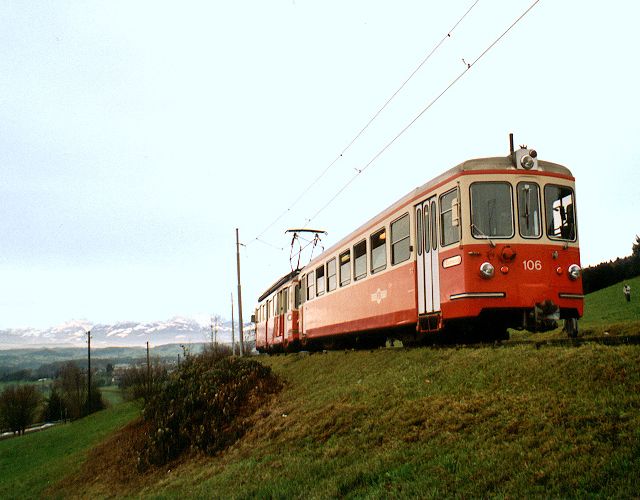Latest news
news index
older news items
all news for current year index, on one page
This website:
news search.
Zürich tram home page.
photos.
events diary.
Zürich tram links.
guestbook.
Train Urbain de Tana back on track?
filed on: 06.02.2007 (6th Feb 2007)
Readers who have been following the news on these pages over the last two years will be aware of the ex-Forchbahn BDe4/4 and Bt4 vehicles that have been been shipped to Madagascar for the purpose of inaugurating a tram service in the capital, Antananarivo.
 Operation of this vehicle type on Forchbahn ended in the autumn of 2004. The vehicles were shipped to Madagascar in two batches, the second of which arrived in Antananarivo last March. In addition to Forchbahn 11-16 and 101-106, TB (Trogenerbahn) contributed BDe4/4 6 and MGB (Matterhorn-Gotthard-Bahn) the luggage vans Z 100 and DZ 4354. It is planned to fit the latter vans with diesel-powered generators because electrification of the line in Madagascar is currently out of the question. These vehicles were all taken by rail to Basel, and then by boat to Antwerpen. From here they went by ship to the Malagache port of Toamasina, being allowed to run the final leg to Antananarivo on their own wheels hauled by a diesel locomotive (the railways of Madagascar being metre gauge).
Operation of this vehicle type on Forchbahn ended in the autumn of 2004. The vehicles were shipped to Madagascar in two batches, the second of which arrived in Antananarivo last March. In addition to Forchbahn 11-16 and 101-106, TB (Trogenerbahn) contributed BDe4/4 6 and MGB (Matterhorn-Gotthard-Bahn) the luggage vans Z 100 and DZ 4354. It is planned to fit the latter vans with diesel-powered generators because electrification of the line in Madagascar is currently out of the question. These vehicles were all taken by rail to Basel, and then by boat to Antwerpen. From here they went by ship to the Malagache port of Toamasina, being allowed to run the final leg to Antananarivo on their own wheels hauled by a diesel locomotive (the railways of Madagascar being metre gauge).
Various cynics have seen the whole procedure as just a cheap way of disposing of unwanted rolling stock while veiled in a pretence of philanthropy. The prolonged periods of silence and the slow pace of progress have certainly not helped counter such suspicions. For example, some of the vehicles were marooned in Antwerpen for an extended period and were even threatened with scrapping while the promotors in Madagascar struggled to find money for the onward shipment. A lot of the news that comes back from African aid projects certainly is tainted by the bitter marks of waste, poor planning and little effect — problems that good intention alone cannot offset. It seems to me, however, that the case of Madagascar is very different. There has been a considerable contribution to this project from the Madagascar side, and it enjoys the personal support of Antananarivo's major Patrick Ramiaramanana. Also, if other projects are anything to go by (such as the refurbishment of the railways), the achievements of this island have a model status.
While donating surplus rolling stock certainly doesn't have the elements of philanthropy that famine or medical relief present, the value of this contribution should not be easily shrugged aside. The author believes that aid should not concentrate exclusively on the poorest among the poor but also bolster up stronger sectors to improve the economic viability of regions. Transport infrastructure is a prime ingredient of such viability, and in contrast to mammouth investments by multinationals such as oil or mining corporations, it remains under local accountability and provides immediate and sustainable benefits to a broad range of local people. The low-cost nature yet inherent technical soundness of the proposal at hand make it a model that should be considered for emulation not only in developing economies but also more globally.
Torn between the alternative scenarios of success or abandonment, it comes as a great relief to find further news from Antananarivo on the Internet. The website of Chambre de Commerce, d'Industrie, d'Artisanat et d'Agriculture of Antananarivo carries an article dated 4th January and quoted from L'Express de Madagascar. The article laments that two years have passed since the arrival of the (first) vehicles in Antananarivo. but that the minister of transport and public works is seeking offers from the private sector for the operation of the service. An investment of 80,000 Euros is estimated for the fitting of diesel generators. Additionally, the tracks will require some attention before services can commence. The trains that will be operated will have a capacity of 250 passengers, and serve the corridors Soarano — Soanierana — Tanjombato — Ambatofotsy and Soarano — Alarobia (the system will be known as Train Urbain de Tana). The goal is to relieve congestion in the city centre and will allow measures such as restrictions on access by taxis to further this purpose.
Further news articles on this project.
This news item is from the 2007 newslog.
search Zürich tram news archive
news index for displayed year (2007)
news index for 2025
all news for current year
Zürich tram homepage
to link to this item please use:
http://www.proaktiva.ch/tram/zurich/newslog/newsitem.php?year=2007&item=060207